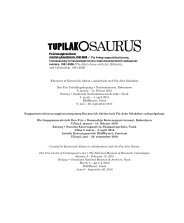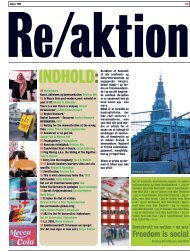tupilakosaurus - Print matters!
tupilakosaurus - Print matters!
tupilakosaurus - Print matters!
You also want an ePaper? Increase the reach of your titles
YUMPU automatically turns print PDFs into web optimized ePapers that Google loves.
eSKIMUU SILANNgA-<br />
JAARTOg<br />
luni. Taakku pipput Nationalmuseumimi,<br />
Kalaallit Illuutaanni Københavnimilu Arktisk<br />
Intitutimi, ingerlanneqartarlutillu SfDEF-imit<br />
aallarniuteqarnikkut, filmip ataatsip arlallilluunniit<br />
takutinnerisigut kingornatigullu<br />
najuuttunik oqallitsitsinikkut.<br />
Filmit tamanik samminnittuupput ilagalugulu<br />
nipeqanngitsumik filmiliaq Den store<br />
Grønlandsfilm 1921-meersoq, ilitsersuisoralugit<br />
Eduard Schnedler-Sørensen & H.F.<br />
Rimmen, filmiliarineqarlunilu “Thulemiit<br />
ilisimasassarsiornerit 5”-ata, issittumi ilisimasassarsiortartumit<br />
tusaamasaasumit Knud<br />
Rasmussenimit siulersorneqartup, aallartinissarnerata<br />
nalaani. Aammattaarli filmiliat<br />
nutaanerusut ilaapput soorlu Martin Appelt &<br />
Ole Mallingip pisimasulersaarutaat Tunit – det<br />
forsvundne folk 1998-imeersoq (DR 2-mi 1999imi<br />
takutinneqartoq ilaavoq).<br />
Filmit takutinneqartut qulequtserneqarnerannut<br />
tunngaviupput aallaaserisat naatsut<br />
taama qulequtallit, Erik Gantip atuagassiami<br />
Tidsskriftet Grønland-imi 1996-imi saqqummersittagai.<br />
Taama qulequtsiinermigut uparuarniarpaa<br />
Nunat Killiit “eskimuumik” eqqunngitsumik<br />
ilisarititsisarnerat qaqortumik amilimmit allaanerulluni<br />
“eqqumiikajaartuunerarlugu”, uparuarniarluguttaaq<br />
nammineq “eqqumiikajaatut”<br />
inissisimanini ullumikkut “kalaaliusutut”,<br />
eqqunngitsumik ilisarititsinernit taakkunannga<br />
nikilluni isiginnaartutut, taamalu nikinnikkut<br />
uppernarsisariaqarlugu, tunuannulluunniit<br />
pisinnaagaluaruni, qangatut “eskimuujussusermut”<br />
utersinnaanani. Kalaaleq eqqumiikajaaq<br />
tassanngaanniit isigalugu tassaavoq nungukkiartuutigaluni<br />
assersuutissanngoriartortoq<br />
pitsaasoq – “taama sakkussalersorneqarnitsivut<br />
malugisinnaalluarparput namminiussuseq aammattaaq<br />
tassaasoq tamatigut allaanissaq”, soorlu<br />
Gantip allatani naggaseraa.<br />
Filmertitsiviup immikkoortortaani<br />
anguniarneqarpoq “eskimuujussutsimik”<br />
ilisarititsinerit ilaasa, Arkep allallu nunasiaataanerup<br />
kingornagut assilialiortartut uparuartorniagaasa,<br />
erseqqissarnissaat: Eskimuut<br />
nagguiat, ilakkuminarnerat, pissuseqqaanut<br />
qaninnerat, meerarpalunnerat, ataatsimoorussisarnerat,<br />
imminut naapertuuttumik<br />
tunngavilersorluni eqqarsartaasiat, piuaatsuunerat<br />
inuunermillu nuannaarutiginninnermik<br />
ingerlaannaq takutitsisarnerat.<br />
Film-it takutitassat marluupput, ataani<br />
qulequttat atuakkit. Paarla kaallutik ulloq<br />
allortarlugu takutinneqartassapput katersugaasiviup<br />
ammasarfiani:<br />
Eduard Schnedler-Sørensen & H.F. Rimmen.<br />
Den store Grønlandsfilm. 1921.<br />
Leo Hansen. Med Hundeslæde gennem<br />
Alaska. 1926.<br />
Aammattaaq jannuaarip 23-anni aamma<br />
martsi 10-anni 2010 tamanut ammasumik<br />
oqallitsitsineqassaartaaq, SfDEF-ip anersaava<br />
malillugu filmi kingulliullugu taasaq takutinneqassalluni<br />
oqallissutigineqarlunilu.<br />
THEME SECTION 8: THE ECCENTRIC ESKIMO<br />
This section diverges a little from the<br />
others. It contains only one work by Pia<br />
Arke, namely a series of eight colour<br />
photographs from the 1990s that soberly<br />
register deposits and imprints that in<br />
all their ochre beauty bear witness<br />
to the onetime presence of European<br />
patrols and outposts. The place is East<br />
Greenland, and the deposits come from<br />
objects – trashed oil drums, sheet metal,<br />
lamps, etc. – which rusted away in the<br />
course of time and have become one with<br />
that very same stony ground that their<br />
original owners so diligently studied and<br />
processed.<br />
The references in the series to polar<br />
expeditions at distant outposts are<br />
reflected in the section’s tent that<br />
forms the setting for a film programme<br />
curated by the Society for Ethnographic<br />
Film Blunders (SfEFB), presenting two<br />
classical ethnographic films during the<br />
exhibition. The society with the unusual<br />
name was founded by Arke, her brother<br />
Erik Gant and Anders Jørgensen at the<br />
beginning of the year 2000. While Gant<br />
and Jørgensen had both investigated<br />
cinematic representations of Greenlanders<br />
and Inuit in university theses – Gant<br />
in his Ph.D. thesis Eskimotid [Eskimo<br />
Time] (2004-05) and Jørgensen in his<br />
graduate thesis Det primitive moderne.<br />
Knud Rasmussens etnografiske ekspeditionsfilm<br />
1917-1927 [The Primitive Modern:<br />
Knud Rasmussen’s Ethnographic<br />
Expedition Films 1917-1927] (2000)<br />
– Arke had occupied herself broadly<br />
with the importance of pictorial media<br />
in the mapping and colonisation of East<br />
Greenland in particular.<br />
The three shared not only an interest<br />
in investigating how indigenous peoples<br />
– therefore also “Eskimos” – have been<br />
represented in Western ethnography<br />
and films over the last nine decades.<br />
They also wished to discuss with the<br />
general public what they saw and, if<br />
possible, to reverse the ethnographic<br />
and filmic gaze so that it could see itself.<br />
In other words, they took the same<br />
viewing angle that the ethnographic<br />
film has imposed on indigenous peoples<br />
in order to apply it to ethnographic film<br />
itself. It goes without saying that in this<br />
process the focus fell on the ethnographers,<br />
archaeologists, filmmakers and<br />
TV people, who made the films, and in<br />
a further sense on the cinemagoers and<br />
TV viewers, who had seen them and<br />
taken the films for gospel.<br />
Thus, with analysis and satire as<br />
their weapons SfEFB sallied forth and<br />
arranged a number of public séances,<br />
as they called them. They took place at,<br />
for instance, the National Museum of<br />
Denmark, the Greenland House and the<br />
Danish Polar Center in Copenhagen and<br />
were built up around an introductory<br />
presentation from SfEFB, the showing<br />
of one or more films and a subsequent<br />
discussion with the audience.<br />
The film material covered a lot of<br />
ground and included an early silent film<br />
like Den store Grønlandsfilm [The Great<br />
Greenland Film] from 1921, directed<br />
by Eduard Schnedler-Sørensen & H.F.<br />
Rimmen, and filmed during the first half<br />
of the so-called “5th Thule Expedition”<br />
under the leadership of the renowned polar<br />
explorer Knud Rasmussen. But also<br />
more recent material, like Martin Appelt<br />
& Ole Malling’s documentary Tunit – det<br />
forsvundne folk [Tunit – The People that<br />
Disappeared] from 1998 (screened on<br />
Danish television in 1999), formed part<br />
of the material shown.<br />
The film programme takes its title<br />
from an essay of the same name that<br />
Erik Gant published in Tidsskriftet<br />
Grønland in 1996. His title refers both<br />
to the West’s misrepresentations of<br />
“the Eskimo” as “eccentric” in her/his<br />
difference from white people and to his<br />
own “eccentric” position as a modern<br />
“Greenlander”, who regards these<br />
misrepresentations displaced from<br />
them, and who in this displacement is<br />
forced to recognise that even if he could<br />
go behind them, there is no way back to<br />
the original “Eskimoicity”. In this optic<br />
the eccentric Greenlander is at one and<br />
the same time in the process of going<br />
under and on the way to becoming a<br />
good example – “equipped as we are<br />
with a sure sense that being oneself is<br />
also always to be something else”, as<br />
Gant concludes his text.<br />
With the film programme this section<br />
wishes to spell out some of the “Eskimoic”<br />
representation models that Arke<br />
and other postcolonial artists have<br />
tried to confront: Eskimoic originality,<br />
naturalness, primitiveness, childishness,<br />
collectivism, pre-logic, peaceableness and<br />
spontaneous joie-de-vivre.<br />
The film programme consists of<br />
the two films listed below, which are<br />
screened alternately every day during<br />
museum opening hours:<br />
Eduard Schnedler-Sørensen & H.F.<br />
Rimmen. Den store Grønlandsfilm [The<br />
Great Greenland Film]. 1921.<br />
Leo Hansen. Med Hundeslæde<br />
gennem Alaska [With a Dog Sledge<br />
Through Alaska]. 1926.<br />
On January 23 and March 10, 2010<br />
two public discussion séances will be<br />
held, at which in SfEFB’s spirit we will<br />
show and discuss the last-mentioned<br />
film. For more info, see “Events during<br />
the exhibition” on p. 76.<br />
61




